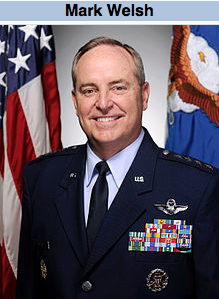
[SatNews] It is imperative to modernize the Air Force despite difficult budgeting choices that will have to be made, Air Force Chief of Staff Gen. Mark A. Welsh III said today in Orlando, Florida.

Speaking during the Air Force Association Air Warfare Symposium and Technology Exposition, the general discussed the need for force modernization.
“We must modernize the Air Force,” he said. “This isn’t optional; we must do it. And it will be painful, because we have to make very difficult choices to get the money inside our topline at current funding levels to do it.”
Aging Fleets
Welsh explained how aging fleets and less personnel strength can affect the Air Force’s mission.
“Most of you will remember Desert Shield and Desert Storm,” he said. “When we deployed in 1990 to that conflict, the United States Air Force had 188 fighter squadrons—188. In the FY ‘16 budget, we’ll go to 49; 188 to 49.”
Welsh noted in 1990, there were 511,000 active duty airmen; now the Air Force has 313,000—a 40 percent smaller force.
“There is no excess capacity anymore,” he said. “There is no bench to go to in the Air Force. Everything’s committed to the fight.”
“I’d love to be able to tell you that, that much smaller force is more modern, more capable [and] younger, but I can’t,” Welsh said.
Providing perspective on the age of the fleet, Welsh said during Desert Storm the Boeing B-17 Flying Fortress wasn’t considered for bombing Baghdad.
“If we had used the B-17 in the first Gulf War,” he said, “it would have been five years younger at that time than the B-52, the KC-135 and the U-2 are today.”
“We have 12 fleets of airplanes … that qualify for antique license plates right here in the great state of Florida,” Welsh said. “And we have four that qualify for … [AARP].”

NASCAR Analogy
The general used a NASCAR race picture led by the #43 Air Force-sponsored stock car to further drive home his point.
“Four laps before this picture was taken, the 43 car had a four- to five-car-length lead,” Welsh said.
“For the last couple of laps, the #41 and #55 cars have been steadily closing,” he said. “The gap’s shrinking just like our technology lap, just like our capacity gap is shrinking.”
When do we get to the point, Welsh asked, where no matter how fast #43 tries to accelerate, the momentum gained by 41 and 55 puts them in the lead?
“That’s the game we’re playing,” he said. “Tough game; maybe a dangerous one.”
Resetting the Force
Welsh said Air Force leadership has been trying to reset some areas for the last couple of years.
“Not because they’re broken,” he said, “not because we’re not doing great work, but because we need to reset some things. We’ve done this before.”
Following World War I, Welsh said, the Army Air Corps noted the “big lessons” learned, which were reconnaissance and pursuit. Then, he said, during World War II the lessons of strategic bombardment became clear.
“We came out of World War II with this idea that strategic bombardment was the future of air forces,” Welsh said. Except for a tactical diversion in Korea, he said, the service’s leaders focused on building the best strategic Air Force they could.
The general said Vietnam yielded tactical lessons learned, which led to a “really good” tactical and strategic Air Force.
Then 1990 came, Welsh said, “and we made Operation Desert Storm look ridiculously easy.
“It wasn’t that easy, but we were that good and that large,” he said. “And then for the last 25 years, we’ve been fighting a different type of enemy—a shadowy enemy, harder to pin down, harder to isolate.”
Serving in more of a counterinsurgency supporting role, Welsh said, the Air Force “revolutionized and gave birth” to an entirely new generation of intelligence, surveillance and reconnaissance capability, and a new understanding of how it could be used.
“Where we’ve come in the last 25 years in ISR is stunning,” he said. “We operationalized space capabilities; we jumped into the cyber domain. But it’s been about 25 years and that’s about the cycle for these resets– it’s time to do it again.”
Next for the Air Force
Welsh noted there are specific areas in need for reset—namely infrastructure.
“We’ve spent a lot of time lately taking money out of this [area] to pay for operational activity as our budgets were stressed,” he said.
“But there is infrastructure in our Air Force which creates mission capability,” Welsh said. “I’ll refer to it as critical mission infrastructure. This isn’t something [like] you can just not build another dorm and it won’t hurt you over time … this is stuff that will keep you from developing combat capability.”
This infrastructure, he said, includes test facilities, training ranges and simulation, education infrastructure and nuclear infrastructure—things that the service cannot do without.
“We have got to get back,” Welsh said, “to a persistent, consistent investment in this kind of infrastructure, or our Air Force will break 10 years from now.”
By Army Sgt. 1st Class Tyrone C. Marshall Jr.
DoD News, Defense Media Activity

